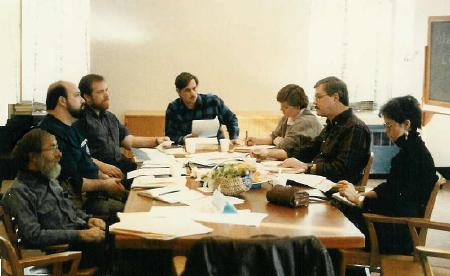Stories
The Seville Statement Newsletter
Mayor DiLieto and the Peace Commission
Plans for
a general human theory
Facing the internal culture of war
Student Conferences at Wesleyan
Shell mobiles
* * *
The Seville Statement on Violence
Everything is timing.
A good illustration was the initiative that was not carried out in 1992, at a particular moment, and then was no longer possible.
The Democrats were winning the election and would replace Bush with Clinton. The Soviet Union and the socialist countries of Eastern Europe had collapsed. Gorbachev had made good on his promise to deprive the US of an enemy. There was a window of opportunity.
I worked with officers of the International Association of Machinists in Connecticut, including Craig Gauthier of New Haven Winchester, Pete Tinella of Southington Pratt & Whitney and David Smallcombe of North Haven Pratt & Whitney, to develop a petition for their union members and those of the United Auto Workers. Between these two unions they held most of the defense jobs in Connecticut, which was the most heavily dependent state in the USA for military contracts.
Recognizing that defense contracts are notoriously unreliable, the petition called for the retooling of military industry to produce a national system of mass transportation, as well as double-hulled tankers for transporting oil. It called for in-plant committees of labor, community and management to oversee the conversion.
Economically the idea was to raise taxes on gasoline to the point that gas cost the same as in Europe (double that of the US) and use the revenues to pay for the conversion and establishment of mass transit. With higher gas prices people would be ready to pay for travel by mass transit instead of cars once the system was in place.
The timetable called for the unions to circulate the petition in December both in-plant and to families and local businesses. At the same time the unions would meet with legislators to draft state and federal resolutions and legislation to go along with it.
If our plans worked, at the end of January 1993, millions of signatures would be presented by a demonstration at the inauguration of the new Democratic president, to be followed by intensive lobbying. The campaign was to be labor-led but open to the broadest possible support and alliance with all other organizations.
Well, time ran out and I was hired by UNESCO in December 1992 to come back to Paris to design the culture of peace program. I couldn't do both and there wasn't anybody else sufficiently motivated and available to carry out the petition campaign.

At a meeting of Labor for Peace, along with (left to right) Pete Tinella and John Harrity of the Machinists, Jay Doody of CSEA, State Employees, Linda Buchanon, secretary, Vince Maloney, co-chair, and Lindsay (from HERE Local 34). Click on photo to enlarge.
The conversion initiative was the product of an organization I had helped to found in 1986 called "Connecticut Labor for Peace." We met almost monthly during 1987 and 1988 and helped link activities of the labor movement and peace movement, including one major meeting in October 1991 on Economic Conversion which was held at the 1199 Union Hall in Hartford.
Now, years later, we continue to suffer from loss of manufacturing jobs, weakening of unions, congested highways and lack of mass transit. Sometimes I wonder if I would have done more good by staying in the US instead of going to Paris to start the culture of peace. Who knows? And besides, the book by Bob Woodward called The Agenda suggests that Clinton's economic policies were already so determined by the big bankers that there would have been no chance for this program.
 |
Stages
1986-1992
Fall of Soviet Empire
1992-1997
UNESCO Culture of Peace Programme
1997-2001
UN Intl Year for Culture of Peace